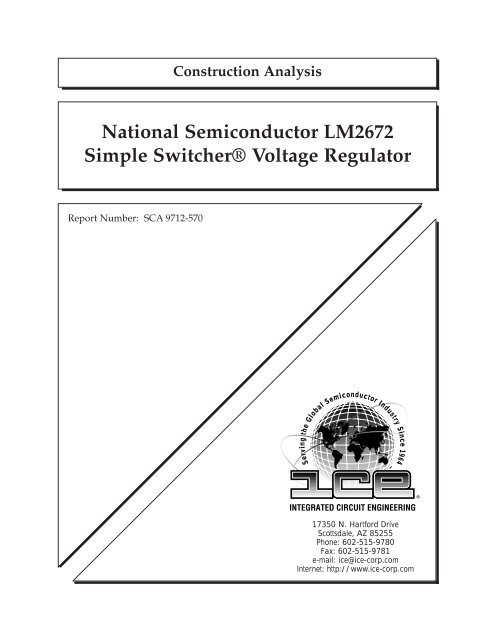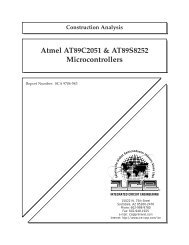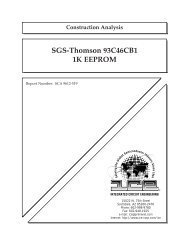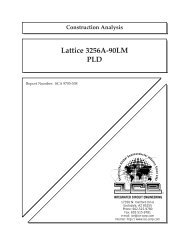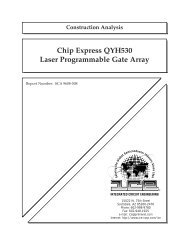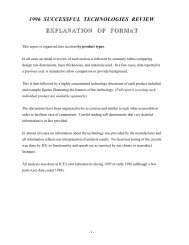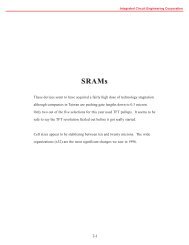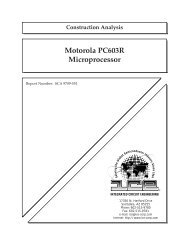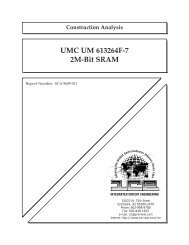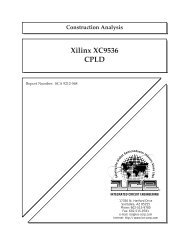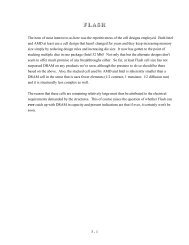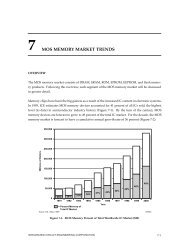ICE Shared Construction Analysis SCA 9712-570 - Smithsonian ...
ICE Shared Construction Analysis SCA 9712-570 - Smithsonian ...
ICE Shared Construction Analysis SCA 9712-570 - Smithsonian ...
You also want an ePaper? Increase the reach of your titles
YUMPU automatically turns print PDFs into web optimized ePapers that Google loves.
<strong>Construction</strong> <strong>Analysis</strong><br />
National Semiconductor LM2672<br />
Simple Switcher® Voltage Regulator<br />
Report Number: <strong>SCA</strong> <strong>9712</strong>-<strong>570</strong><br />
Serving the Global Semiconductor Industry Since 1964<br />
17350 N. Hartford Drive<br />
Scottsdale, AZ 85255<br />
Phone: 602-515-9780<br />
Fax: 602-515-9781<br />
e-mail: ice@ice-corp.com<br />
Internet: http://www.ice-corp.com<br />
®
INDEX TO TEXT<br />
TITLE PAGE<br />
INTRODUCTION 1<br />
MAJOR FINDINGS 1<br />
TECHNOLOGY DESCRIPTION<br />
Assembly 2<br />
Die Process and Design 2 - 3<br />
ANALYSIS RESULTS I<br />
Assembly 4<br />
ANALYSIS RESULTS II<br />
Die Process and Design 5 - 7<br />
TABLES<br />
Procedure 8<br />
Overall Quality Evaluation 9<br />
Package Markings 10<br />
Wirebond Strength 10<br />
Die Material <strong>Analysis</strong> 10<br />
Horizontal Dimensions 11<br />
Vertical Dimensions 12<br />
i
INTRODUCTION<br />
This report describes a construction analysis of the National Semiconductor LM2672<br />
Simple Switcher voltage regulator. Five devices were supplied, encapsulated in 8-pin<br />
Dual-In-Line plastic packages (DIP). Date codes were not identifiable.<br />
Questionable Items: 1<br />
MAJOR FINDINGS<br />
• Metal cracks were noted at contact edges.<br />
• Significant silicon in contacts.<br />
Special Features:<br />
• Linear Power BiCMOS process which includes a double diffused (DMOS) process.<br />
• Extended shallow source/drain N-channel transistor structure.<br />
Design Features:<br />
• Large area for double diffused (DMOS) process.<br />
• Large capacitor structures.<br />
1 These items present possible quality or reliability concerns. They should be discussed<br />
with the manufacturer to determine their possible impact on the intended application.<br />
- 1 -
Assembly:<br />
TECHNOLOGY DESCRIPTION<br />
• Devices were encapsulated in 8-pin plastic DIPs.<br />
• Lead-locking provisions (anchors and holes) were present at all pins.<br />
• Thermosonic ball bond method employing 1.3 mil O.D. gold wire.<br />
• Silver-filled polyimide die attach.<br />
• Sawn dicing (full depth).<br />
Die Process and Design<br />
• Fabrication process: Linear Power BiCMOS process with N-epi, P-well, P+ iso,<br />
and N+ buried layer, incorporating N and P channel MOS, DMOS, NPN and PNP<br />
transistors.<br />
• Final passivation: Two layers of passivation were employed. A layer of nitride over<br />
a layer of silicon-dioxide.<br />
• Metallization: Two levels of silicon-doped aluminum defined by dry-etch<br />
techniques. No caps or barriers were present. Standard contacts and vias (no<br />
plugs). In the DMOS area metal 2 was placed directly on metal 1.<br />
• Intermetal Dielectric (IMD): Intermetal dielectric consisted of single layer of glass.<br />
No planarization technique was used.<br />
• Pre-metal glass: A single layer of reflow glass was used. Reflow was done prior to<br />
contact cuts. Grown and densified oxides were also present.<br />
- 2 -
TECHNOLOGY DESCRIPTION (continued)<br />
• Polysilicon: Single layer of dry-etched polysilicon (no silicide) was used to form all<br />
MOS gates on the die. It was also used as the top plate for the thin oxide capacitors.<br />
An LDD process was used with spacers removed.<br />
• DMOS devices: A double diffused Hexfet style process was employed. N+<br />
diffusions formed the sources of the transistor elements. Deep P+ diffusions<br />
formed the body and inherent body diode. N- epi/buried layer formed the drain.<br />
• CMOS devices: Standard N+ and P+ implanted diffusions formed the<br />
sources/drains for these transistors. Sidewall spacers were selectively used and<br />
removed. Long shallow N+ LDD extensions were present on one side of some of<br />
the NMOS transistors. P-wells and N-epi were used for N-channel devices.<br />
• Bipolar devices: Standard N+ diffusions were used for emitters and collectors of<br />
NPN’s and base contacts of PNP devices. The standard base diffusions also used a<br />
shallow P+ implant (probably the S/D P+) at contact areas. P+ isolation diffusions<br />
were diffused from top and bottom of the epi (to reduce isolation width).<br />
• No buried contacts were employed.<br />
- 3 -
Assembly:<br />
ANALYSIS RESULTS I<br />
- 4 -<br />
Figures 1 - 4a<br />
Note: Package analysis was not required. The following data was obtained by observation<br />
and is given here as general information.<br />
Questionable Items: 1 None.<br />
General Items:<br />
• Devices were packages in 8-pin plastic DIPs.<br />
• Package markings were clear and easy to read. Date codes were not identifiable.<br />
• Overall package quality: Normal. No defects were noted on the external portions of<br />
the package. Deflash was of normal quality and workmanship. Lead form was of<br />
normal quality and workmanship. No problems were found.<br />
• Die placement: Die was centered and silver-filled polyimide die attach was of good<br />
quantity and quality. No problems were found.<br />
• Lead-locking provisions (anchors and holes) were present at all pins.<br />
• Wirebonding: Thermosonic ball bond method using 1.3 mil O.D. gold wire. No<br />
bond lifts occurred and bond pull strengths were good (see page 8). Metal 2 on 1<br />
formed the bond pads. Wire spacing and placement was good. Probe mark damage<br />
was noted at some test pads. The damage decreased the metal spacing; however, no<br />
shorts were noted.<br />
• Die dicing: Die separation was by full depth sawing with good quality<br />
workmanship.<br />
1 These items present possible quality or reliability concerns. They should be discussed<br />
with the manufacturer to determine their possible impact on the intended application.
Die Process and Design:<br />
Questionable Items: 1<br />
ANALYSIS RESULTS II<br />
• Metal cracks were noted at contact edges.<br />
• Significant silicon in contacts.<br />
- 5 -<br />
Figures 5 - 31<br />
Special Features:<br />
• Linear Power BiCMOS process which includes a double diffused (DMOS) process.<br />
• Extended shallow source/drain N-channel transistor structure.<br />
Design Features:<br />
• Large area for double diffused (DMOS) process.<br />
• Large capacitor structures.<br />
General Items:<br />
• Fabrication process: Linear Power BiCMOS process with N-epi, P-well, P+ iso, and<br />
N+ buried layer, incorporating N and P channel MOS, DMOS, NPN and PNP<br />
transistors.<br />
• Design and layout: Die layout was clean and efficient. The identification number on<br />
the die was 2675.<br />
• Die surface defects: None. No contamination or processing defects were noted.<br />
1 These items present possible quality or reliability concerns. They should be discussed<br />
with the manufacturer to determine their possible impact on the intended application.
ANALYSIS RESULTS II (continued)<br />
• Final passivation: The passivation consisted of a layer of nitride over a layer of<br />
silicon-dioxide. Passivation integrity test indicated defect free passivation. Edge<br />
seal was also good. Some residual metal was noted at the die edge; however, no<br />
problems are foreseen (Figures 3 and 3a).<br />
• Metallization: Two levels of metal defined by a dry-etch of normal quality. Metal<br />
consisted of silicon-doped aluminum. No cap or barrier metals were employed.<br />
Standard vias and contacts were used (no plugs).<br />
• Metal defects: None. No notching of the metal layers was present. There was<br />
significant silicon mound growth in contact areas following the removal of the metal<br />
in the MOSFET area. Worst case silicon mound growth occupied up to 40 percent<br />
of contacts and is shown in Figure 24. Cracks were noted at contact edges see<br />
Figures 26, 27 and 29.<br />
• Metal step coverage: No significant metal thinning occurred at vias or contacts due<br />
to the sloped contact cuts.<br />
• Contacts: Contact cuts appeared to be defined by a wet-etch technique of good<br />
quality. No significant over-etching of the contacts was present. No contact pitting<br />
was present. Substrate contacts were used to bias the P-wells (Figure 19).<br />
• Intermetal Dielectric (IMD): Intermetal dielectric consisted of single layer of glass.<br />
No planarization technique was used. No problems were present.<br />
• Pre-metal glass: A single layer of reflow glass was used over grown oxides. No<br />
problems were found.<br />
- 6 -
ANALYSIS RESULTS II (continued)<br />
• Polysilicon: Single layer of dry-etched polysilicon (no silicide) was used to form all<br />
MOS gates on the die. It was also used as the top plate for the thin oxide capacitors<br />
and gates for the DMOS structure. The LDD process used sidewall spacers which<br />
were removed. Large poly capacitor structures were used throughout entire die. No<br />
poly resistors were present. No problems were present.<br />
• Isolation: N-epi islands with N+ buried layer separated by P+ isolation. There was<br />
good separation between buried layer and isolation with minimal buried layer shift.<br />
P-wells were noted in N-epi for N-channel devices. P+ isolation (up and down)<br />
diffusions were used to isolate the N-epi islands. A step in the oxide was noted at<br />
the P+ iso diffusions.<br />
• DMOS devices: A double diffused process was employed. N+ diffusions formed<br />
the sources of the transistor elements. Deep P+ diffusions formed the body and<br />
inherent body diode. N- epi/N+ buried layer formed the drain.<br />
• CMOS devices: Standard N+ and P+ implanted diffusions formed the<br />
sources/drains for these transistors. Some NMOS transistors used a unique LDD<br />
extension on one side of the gate. The step in the oxide would indicates this<br />
although the implant was too light to delineate.<br />
• Bipolar devices: All bipolar devices were located in N-epi/N+ buried layers.<br />
Standard N+ diffusions were used for emitters and collectors of NPN’s and base<br />
contacts of PNP devices. The standard base diffusions also used a shallow P+<br />
implant (probably the S/D P+) at contact areas. P+ isolation diffusions were<br />
diffused from top and bottom of the epi (to reduce isolation width).<br />
- 7 -
PROCEDURE<br />
The devices were subjected to the following analysis procedures:<br />
External inspection<br />
X-ray<br />
Decapsulation<br />
Internal optical inspection<br />
SEM inspection of assembly features and passivation<br />
Wirepull test<br />
Passivation integrity test<br />
Passivation removal and inspect metal 2<br />
Delayer to metal 1 and inspect<br />
Delayer to poly and inspect poly structures and die surface<br />
Die sectioning (90° for SEM) *<br />
Measure horizontal dimensions<br />
Measure vertical dimensions<br />
Material analysis<br />
* Delineation of cross-sections is by silicon etch unless otherwise indicated.<br />
- 8 -
OVERALL QUALITY EVALUATION: Overall Rating: Normal<br />
DETAIL OF EVALUATION<br />
Package integrity N<br />
Package markings G<br />
Die placement G<br />
Die attach quality G<br />
Wire spacing G<br />
Wirebond placement G<br />
Wirebond quality G<br />
Dicing quality N<br />
Wirebond method Thermosonic ball bonds using 1.3<br />
mil gold wire.<br />
Dicing method: Sawn (full depth)<br />
Die attach: Silver-filled polyimide<br />
Die surface integrity:<br />
Tool marks (absence): NP (probe damage)<br />
Particles (absence): N<br />
Contamination (absence): N<br />
Process defects (absence): N<br />
General workmanship N<br />
Passivation integrity G<br />
Metal definition N<br />
Metal integrity NP (cracks at contact edges)<br />
Contact coverage G<br />
Contact registration N<br />
Contact defects NP (some significant silicon mound<br />
growth)<br />
G = Good, P = Poor, N = Normal, NP = Normal/Poor<br />
- 9 -
PACKAGE MARKINGS<br />
Top<br />
(National logo) 66AB<br />
2672 M3.3<br />
Bottom<br />
none<br />
WIREBOND STRENGTH<br />
Wire material: 1.3 mil diameter gold<br />
Die pad material: Aluminum<br />
sample 4<br />
# of wires tested: 11<br />
Bond lifts: 0<br />
Force to break - high: 18g<br />
- low: 17g<br />
- avg.: 17.9g<br />
- std. dev.: 0.28<br />
DIE MATERIAL ANALYSIS<br />
Passivation: Nitride over silicon-dioxide.<br />
Die metallization: Aluminum.<br />
Intermetal dielectric: Silicon-dioxide.<br />
Pre-metal glass: Single layer of reflow glass. Grown and densified oxides<br />
were also present.<br />
- 10 -
HORIZONTAL DIMENSIONS<br />
Die size: 1.8 x 3.5 mm (73.5 x 140.5 mils)<br />
Die area: 6.3 mm 2 (10,326 mils 2 )<br />
Min pad size: 0.13 mm x 0.13 mm (5.1 x 5.1 mils)<br />
Min pad window: 0.11 mm x 0.11 mm (4.4 x 4.4 mils)<br />
Min metal 2 width: 7.3 microns<br />
Min metal 2 space: 7.7 microns<br />
Min metal 2 pitch: 15 microns<br />
Min via: 5.3 microns<br />
Min metal 1 width: 3.4 microns<br />
Min metal 1 space: 4.3 microns<br />
Min metal 1 pitch: 7.7 microns<br />
Min contact: 3 microns<br />
Min poly width: 3.7 microns<br />
Min poly space: 4.7 microns<br />
Min gate length*<br />
- (N-channel) 3.7 microns<br />
- (P-channel) 5.0 microns<br />
Min N+ emitter: 16 microns (round)<br />
Min P+ emitter: 12 microns (round)<br />
Min P+ isolation: 10 microns<br />
Min edge of base to P+ iso: 12 microns<br />
Min emitter to edge of base: 8 microns<br />
* Physical gate length<br />
- 11 -
VERTICAL DIMENSIONS<br />
Die thickness: 0.35 mm (14 mils)<br />
Layers<br />
Passivation 2: 1.0 micron<br />
Passivation 1: 0.45 micron<br />
Aluminum 2: 2 microns<br />
Intermetal dielectric (IMD): 0.95 micron<br />
Aluminum 1: 0.75 micron<br />
Pre-metal glass: 0.65 micron<br />
Poly: 0.4 micron<br />
Local oxide: 1 micron<br />
N+ S/D diffusion: 0.6 micron<br />
P+ S/D diffusion: 0.45 micron<br />
P DMOS body: 5.5 microns<br />
P+ base (NPN): 2.8 microns<br />
N+ (DMOS): 10 microns<br />
N+ emitter and collector (NPN): 0.6 micron<br />
N- epi: 4.5 microns<br />
P-well: 5.5 microns<br />
N+ buried layer: 24 microns (from surface)<br />
- 12 -
INDEX TO FIGURES<br />
PACKAGE ASSEMBLY Figures 1 - 4<br />
DIE LAYOUT AND IDENTIFICATION Figures 5 - 7<br />
PHYSICAL DIE STRUCTURES Figures 8 - 22<br />
DMOS POWER HEXFET’S Figures 23-24<br />
BIPOLAR DEV<strong>ICE</strong>S Figures 25 - 29<br />
TYPICAL INPUT/OUTPUT CIRCUITRY Figure 30<br />
CROSS SECTION DRAWING Figure 31<br />
ii
National LM2672<br />
top<br />
bottom<br />
Integrated Circuit Engineering Corporation<br />
Figure 1. Package photographs and pinout of the National LM2672 device. Mag. 10x.<br />
CB<br />
SS<br />
SYNC<br />
FB<br />
1<br />
2<br />
3<br />
4<br />
8<br />
7<br />
6<br />
5<br />
V SW<br />
V IN<br />
GND<br />
ON/OFF
National LM2672<br />
PIN 1<br />
top<br />
side<br />
Figure 2. X-ray views of the package. Mag. 10x.<br />
Integrated Circuit Engineering Corporation
National LM2672<br />
DIE<br />
DIE ATTACH ATTACKED<br />
DURING<br />
DECAPSULATION<br />
PADDLE<br />
EDGE OF PASSIVATION<br />
RESIDUAL METAL<br />
Figure 3. SEM views of dicing and edge seal. 60°.<br />
Integrated Circuit Engineering Corporation<br />
Mag. 200x<br />
Mag. 750x<br />
Mag. 1500x
INTERMETAL<br />
DIELECTRIC<br />
PRE-METAL<br />
DIELECTRIC<br />
N+ BURIED LAYER<br />
LOCOS<br />
P+ ISO<br />
Mag. 800x<br />
Mag. 4000x<br />
N-EPI<br />
DIE EDGE<br />
RESIDUAL METAL<br />
Figure 3a. Optical and SEM section views of the die edge seal.<br />
PASSIVATION<br />
DIE EDGE<br />
National LM2672<br />
Integrated Circuit Engineering Corporation
National LM2672<br />
Au<br />
LEADFRAME<br />
Au<br />
Figure 4. SEM views of typical wirebonds. Mag. 500x, 60°.<br />
Integrated Circuit Engineering Corporation
IMD<br />
LOCAL OXIDE<br />
PASSIVATION<br />
METAL 2<br />
P+ ISO<br />
Au BOND<br />
INTERMETALLIC<br />
N-EPI<br />
Mag. 500x<br />
METAL 1<br />
Mag. 6500x<br />
N+ BURIED<br />
LAYER<br />
M2-M1<br />
Au BOND<br />
Figure 4a. Optical and SEM section views of the bond pad structure.<br />
National LM2672<br />
Integrated Circuit Engineering Corporation
National LM2672<br />
1<br />
C B<br />
2<br />
SS<br />
4<br />
SYNC<br />
4<br />
FB<br />
2<br />
Integrated Circuit Engineering Corporation<br />
5<br />
ON/OFF<br />
Figure 5. Whole die photograph of the National LM2672 device. Mag. 60x.<br />
8<br />
V SN<br />
8<br />
7<br />
VIN 7<br />
6<br />
GND<br />
6<br />
GND
National LM2672<br />
Figure 5a. Detailed optical view of the DMOS area. Mag. 100x.<br />
Integrated Circuit Engineering Corporation
National LM2672<br />
Figure 5b. Detailed optical view of the linear device area. Mag. 100x.<br />
Integrated Circuit Engineering Corporation
Mag. 400x<br />
Mag. 500x<br />
Figure 6. Die identification markings from the surface.<br />
Mag. 800x<br />
Mag. 500x<br />
National LM2672<br />
Integrated Circuit Engineering Corporation
National LM2672<br />
Figure 6a. Additional die markings from the surface.<br />
Integrated Circuit Engineering Corporation<br />
Mag. 500x<br />
Mag. 800x<br />
Mag. 800x
Figure 7. Optical views of the die corners on the National LM2672 device. Mag. 200x.<br />
National LM2672<br />
Integrated Circuit Engineering Corporation
National LM2672<br />
Mag. 1000x<br />
Mag. 3100x<br />
Figure 8. SEM views illustrating passivation coverage. 60°.<br />
Integrated Circuit Engineering Corporation
National LM2672<br />
METAL 1<br />
POLY<br />
N+<br />
PRE-METAL GLASS<br />
PASSIVATION 2<br />
PASSIVATION 1<br />
LOCOS<br />
PASSIVATION<br />
METAL 2<br />
Figure 8a. SEM section views illustrating general construction.<br />
PASSIVATION 2<br />
PASSIVATION 1<br />
METAL 2<br />
IMD<br />
PRE-METAL GLASS<br />
LOCOS<br />
IMD<br />
METAL 1<br />
P-WELL<br />
GATE OXIDE<br />
Figure 9. SEM section view of a metal 2 line profile. Mag. 10,000x.<br />
Si<br />
METAL 2<br />
POLY<br />
Integrated Circuit Engineering Corporation<br />
Mag. 3000x<br />
Mag. 8000x
National LM2672<br />
METAL 2<br />
METAL 2<br />
METAL 2<br />
VIA<br />
METAL 1<br />
Figure 10. Topological SEM views illustrating metal 2 patterning. 0°.<br />
Integrated Circuit Engineering Corporation<br />
Mag. 500x<br />
Mag. 1000x<br />
Mag. 3250x
National LM2672<br />
METAL 2<br />
Mag. 2000x<br />
METAL 2<br />
Mag. 2700x<br />
METAL 1<br />
METAL 1<br />
Figure 11. Perspective SEM views of metal 2 coverage. 60°.<br />
Integrated Circuit Engineering Corporation<br />
POLY
National LM2672<br />
POLY<br />
Figure 11a. Detailed SEM view of a metal 2-to-metal 1 via. Mag. 5000x, 60°.<br />
METAL 1<br />
PASSIVATION 1<br />
Si<br />
PASSIVATION 2<br />
METAL 2<br />
METAL 1<br />
METAL 2<br />
Figure 11b. SEM section view of a metal 2-to-metal 1 via. Mag. 10,000x.<br />
Integrated Circuit Engineering Corporation
National LM2672<br />
PASSIVATION 2<br />
METAL 2<br />
IMD<br />
METAL 1<br />
PASSIVATION 1<br />
STAINING<br />
ARTIFACTS<br />
PRE-METAL GLASS<br />
LOCOS<br />
Mag. 7000x<br />
PASSIVATION 1<br />
IMD<br />
METAL 1<br />
PRE-METAL GLASS<br />
Mag. 20,000x<br />
Figure 12. SEM section views of metal 1 line profiles.<br />
Integrated Circuit Engineering Corporation
National LM2672<br />
METAL 1<br />
POLY<br />
METAL 1<br />
POLY<br />
METAL 1<br />
Figure 13. Topological SEM views illustrating metal 1 patterning. 0°.<br />
Integrated Circuit Engineering Corporation<br />
METAL 2<br />
Mag. 1000x<br />
Mag. 1000x<br />
Mag. 1300x
National LM2672<br />
METAL 1<br />
POLY<br />
POLY<br />
METAL 1<br />
POLY<br />
Figure 14. Perspective SEM views of metal 1 coverage. 60°.<br />
Integrated Circuit Engineering Corporation<br />
METAL 1<br />
Mag. 2400x<br />
Mag. 5000x<br />
Mag. 6500x
National LM2672<br />
BASE<br />
EMITTER<br />
RESISTORS<br />
resistors<br />
METAL 1<br />
NPN transistor<br />
METAL 1<br />
Figure 14a. Additional SEM views of metal 1 coverage. Mag. 1600x, 60°.<br />
Integrated Circuit Engineering Corporation<br />
COLLECTOR
National LM2672<br />
Si<br />
PASSIVATION<br />
IMD<br />
METAL 1<br />
METAL 1<br />
IMD<br />
METAL 1<br />
POLY<br />
LOCOS<br />
CRACK<br />
Figure 15. SEM section views of typical contacts.<br />
N+<br />
P+<br />
Integrated Circuit Engineering Corporation<br />
ARTIFACT<br />
metal 1-to-N+,<br />
Mag. 10,000x<br />
metal 1-to-P+,<br />
Mag. 10,000x<br />
metal 1-to-poly,<br />
Mag. 14,000x
National LM2672<br />
P+<br />
DIFFUSION<br />
Mag. 800x<br />
Mag. 2000x<br />
POLY<br />
DIFFUSION<br />
POLY GATE<br />
Figure 16. Topological SEM views illustrating poly patterning. 0°.<br />
Integrated Circuit Engineering Corporation<br />
N+
National LM2672<br />
Mag. 1300x<br />
DIFFUSION<br />
POLY GATE<br />
Mag. 6500x<br />
POLY<br />
Figure 17. Perspective SEM views of poly coverage. 60°.<br />
Integrated Circuit Engineering Corporation
National LM2672<br />
power HEXFET<br />
poly capacitor<br />
Figure 17a. Additional SEM views of poly structures. Mag. 1600x, 60°.<br />
Integrated Circuit Engineering Corporation<br />
POLY GATE<br />
POLY<br />
PLATE
National LM2672<br />
GATE OXIDE<br />
PASSIVATION<br />
IMD<br />
POLY<br />
GATE OXIDE<br />
Mag. 10,000x<br />
PASSIVATION<br />
IMD<br />
POLY<br />
Mag. 12,000x<br />
Figure 18. SEM section views of typical MOS transistors.<br />
Integrated Circuit Engineering Corporation<br />
P+ S/D<br />
N+ S/D
National LM2672<br />
N-CHANNEL REGION<br />
PASSIVATION<br />
P-WELL<br />
N-EPI<br />
44243<br />
METAL 1<br />
IMD<br />
N+ EXTENSION SUBSTRATE<br />
CONTACT<br />
PASSIVATION<br />
IMD<br />
METAL 1<br />
P+ ISO<br />
N+ S/D<br />
N+ BURIED<br />
LAYER<br />
POLY<br />
N+ S/D<br />
POLY<br />
Figure 19. SEM section views of various N-channel structures.<br />
Integrated Circuit Engineering Corporation<br />
N+<br />
EXTENSION<br />
Mag. 800x<br />
Mag. 6500x<br />
Mag. 8000x
National LM2672<br />
STEP<br />
N+<br />
POLY<br />
GATE OXIDE<br />
GATE OXIDE<br />
STEP<br />
PASSIVATION<br />
IMD<br />
POLY<br />
N+ EXTENSION<br />
METAL 1<br />
N+ S/D<br />
Integrated Circuit Engineering Corporation<br />
N+ S/D<br />
Mag. 12,000x<br />
Mag. 26,000x<br />
Mag. 26,000x<br />
Figure 20. Detailed SEM section views of extended shallow source transistor structure.<br />
POLY<br />
GATE OXIDE
National LM2672<br />
LOCOS<br />
LOCOS<br />
METAL 1<br />
POLY<br />
BIRDSBEAK<br />
DIFFUSION<br />
Integrated Circuit Engineering Corporation<br />
OXIDE<br />
GATE<br />
OXIDE<br />
Figure 21. SEM section views of local oxide birdbeak profiles. Mag. 16,000x.
National LM2672<br />
METAL 1<br />
LOCOS<br />
P- BODY<br />
DIFFUSION<br />
Au BOND<br />
P SUBSTRATE<br />
N-EPI<br />
P+ ISO<br />
STEP<br />
N+ BURIED LAYER<br />
P SUBSTRATE<br />
N+ BURIED LAYER<br />
Figure 22. Optical and SEM section views of the well structure.<br />
Integrated Circuit Engineering Corporation<br />
Mag. 14,000x<br />
DMOS,<br />
Mag. 320x<br />
Mag. 500x
National LM2672<br />
N+ SOURCE<br />
PASSIVATION 2<br />
N+ SOURCE<br />
N+ SOURCE<br />
POLY<br />
N-EPI<br />
(DRAIN)<br />
PASSIVATION 1<br />
METAL 2<br />
METAL 1<br />
P-BODY<br />
POLY<br />
GATE OXIDE<br />
P-BODY<br />
Figure 23. SEM section views of the DMOS Power HEXFET structure.<br />
Integrated Circuit Engineering Corporation<br />
POLY<br />
123<br />
CHANNEL<br />
Mag. 1500x<br />
Mag. 6000x<br />
Mag. 16,000x
National LM2672<br />
METAL 1<br />
Si<br />
Si<br />
POLY<br />
METAL 2<br />
IMD<br />
Integrated Circuit Engineering Corporation<br />
Mag. 10,000x, 0°<br />
Mag. 10,000x, 60°<br />
Mag. 13,000x<br />
Figure 24. SEM views illustrating the silicon mound growth in the HEXFET structures.<br />
Si<br />
POLY<br />
N+
National LM2672<br />
N-EPI<br />
N+ COLLECTOR<br />
N+ EMITTER<br />
P+ BASE<br />
N+ BURIED LAYER<br />
N+ COLLECTOR<br />
E B<br />
P+ ISO<br />
P+ ISO<br />
Figure 25. Optical views of an NPN transistor. Mag. 800x.<br />
Integrated Circuit Engineering Corporation<br />
C<br />
P+ BASE
N+ COLLECTOR<br />
PASSIVATION<br />
P+BASE<br />
N+ EMITTER P+ BASE<br />
CONTACT AREA<br />
Figure 26. SEM section view of an NPN transistor. Mag. 3500x.<br />
National LM2672<br />
Integrated Circuit Engineering Corporation
National LM2672<br />
STEP<br />
PASSIVATION<br />
CRACK<br />
PASSIVATION<br />
METAL 1<br />
PASSIVATION<br />
CRACK<br />
METAL 1<br />
CRACK<br />
METAL 1<br />
P+ ENHANCEMENT DIFFUSION<br />
Figure 27. Detailed views of the NPN transistor. Mag. 8000x.<br />
N+<br />
N+<br />
Integrated Circuit Engineering Corporation<br />
STEP<br />
emitter<br />
collector<br />
base
National LM2672<br />
P+ ISO<br />
P+ EMITTER<br />
N-EPI<br />
P+ EMITTER<br />
P+ COLLECTOR<br />
CONTACT<br />
P+ EMITTER<br />
N+ BASE<br />
P+ COLLECTOR<br />
N+ BURIED LAYER<br />
Figure 28. Optical views of a PNP transistor layout (diode connected).<br />
Integrated Circuit Engineering Corporation<br />
N+ BASE<br />
CONTACT<br />
P+ COLLECTOR<br />
Mag. 500x<br />
Mag. 500x<br />
Mag. 800x
National LM2672<br />
PASSIVATION<br />
METAL 1<br />
P+<br />
Mag. 5000x<br />
CRACK<br />
P EMITTER<br />
IMD<br />
METAL 1<br />
Mag. 13,000x<br />
Figure 29. SEM section views of a P+ emitter on a PNP device.<br />
P+<br />
Integrated Circuit Engineering Corporation<br />
PASSIVATION
National LM2672<br />
PROBE MARK<br />
Integrated Circuit Engineering Corporation<br />
Figure 30. Optical views of probe damage and input layout (Pin 2, SS). Mag. 320x.
P-WELL<br />
POLY<br />
N+ S/D<br />
,,,,,,,,,,<br />
,,,,,,,,,,<br />
N-EPI<br />
ALUMINUM 1<br />
NITRIDE PASSIVATION<br />
ALUMINUM 2<br />
OXIDE OVER N+<br />
P+ ISO<br />
P SUBSTRATE<br />
PRE-METAL GLASS<br />
GLASS PASSIVATION<br />
N+ BURIED LAYER<br />
N+ EMITTER<br />
P+ BASE<br />
Orange = Nitride, Blue = Metal, Yellow = Oxide, Green = Poly,<br />
Red = Diffusion, and Gray = Substrate<br />
INTERMETAL DIELECTRIC<br />
Figure 31. Color cross section drawing illustrating device structure.<br />
OXIDE OVER P+<br />
P+<br />
N+ COLLECTOR<br />
National LM2672<br />
Integrated Circuit Engineering Corporation


